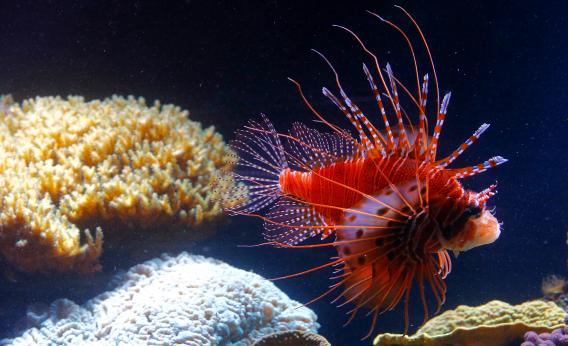 A lionfish in an aquarium
A lionfish in an aquariumPhoto by Alexander Klein/AFP/Getty Images
"Do you know what this is?"?James Morris?looks at me, eyes twinkling, as he?points to the guts of a dissected lionfish in his lab at the National Ocean Service?s Center for Coastal Fisheries and Habitat Research in Beaufort, N.C. I see some white chunky stuff. As a Ph.D. candidate at the Hawaii Institute of Marine Biology, I should know basic fish biology literally inside and out. When I cut open a fish, I can tell you which gross-smelling gooey thing is the liver, which is the stomach, etc.?
He's testing me,?I think to myself. Morris is National Oceanic and Atmospheric Administration's pre-eminent scientist studying the invasion of lionfish into U.S. coastal waters. He?s?the?lionfish guy, and we met in person for the first time just a few days earlier. We're processing lionfish speared by local divers, taking basic measurements, and removing their stomachs for ongoing diet analyses. Not wanting to look bad, I rack my brain for an answer to his question.?It's not gonads. Not spleen. I?m frustrated with myself, but I simply can't place the junk; I've never seen it before. Finally, I give up and admit that I'm completely clueless.
 Close-up on the insides of an obese North Carolinian lionfish
Close-up on the insides of an obese North Carolinian lionfish Photo by Christie Wilcox
"Fat," he says firmly. I look again. The white waxy substance hangs in globs from the stomach and intestines. It clings to most of the internal organs. Heck, there's got to be at least as much fat as anything else in this lionfish's gut. That's when I realize why he's pointing this out.
"Wait ... these lionfish are overweight?" I ask, incredulous.
"No, not overweight," he says. "Obese." The fish we're examining is so obese, he notes, that there are even signs of liver damage.
Obese. As if the lionfish problem in North Carolina wasn't bad enough.
Though comparing invasions is a lot like debating if hurricanes are more devastating than earthquakes, it?s pretty safe to say that lionfish in the Atlantic is the worst marine invasion to date?not just in the United States, but globally. Lionfish also win the gold medal for speed, spreading faster than any other invasive species. While there were scattered sightings from the mid-1980s,?the first confirmation that lionfish were becoming established in the Atlantic Ocean occurred off of North Carolina in 2000. Since then, they have spread like locusts, eating their way throughout the Caribbean and along every coastline from North Carolina to Venezuela, including deep into the Gulf of Mexico. When lionfish arrive on a reef, they?reduce native fish populations by nearly 70 percent. And it?s no wonder?the invasive populations are eight or more times as dense than those in their native range, with?more than?450 lionfish per hectare reported?in some places. That is?a?lot?of lionfish.
These alien fish didn?t just come here on their own. Early guesses as to how the lionfish arrived ranged from ships? ballast water to the coastal damage caused by Hurricane Andrew, but now scientists are fairly sure that no ships or natural disasters are to blame. Instead, it?s our fault. Pretty, frilly fins made the fish a favored pet and lured aquarists and aquarium dealers into a false sense of security. We simply didn?t see how dangerous these charismatic fish were?dangerous not for their venom, but for their beauty. We have trouble killing beautiful things, so instead?we choose to release them into the wild, believing somehow that this is a better option when, in actuality, it?s the worst thing we can do. Released animals rarely survive in the harsh real world, but it?s even worse when they do. Pet releases and?escapees?have become problematic invaders all over the country, from the ravenous pythons in Florida to the feral cats of Hawaii. In the case of lionfish, multiple releases from different owners likely led to enough individuals to start an Atlantic breeding population. Rough genetic estimates suggest that fewer than a dozen female fish began what may go down in history as the worst marine invasion of all time.
 Lots and lots of lionfish caught by the Discovery Diving crew on one day
Lots and lots of lionfish caught by the Discovery Diving crew on one day Courtesy of Discovery Diving
In North Carolina, the lionfish invasion can be seen at its worst. Offshore, where warm waters from the Gulf Stream sweep up the coast, the lionfish reign. Local densities increased 700 percent between 2004 and 2008. I got to witness the unfathomable number of lionfish firsthand when I dove with the crew of Discovery Diving, a local scuba shop, to compete in?North Carolina?s inaugural lionfish derby. I?ve never seen so many lionfish in my life. I didn?t get more than 20 yards from my starting point before I saw hundreds?literally, hundreds. My spear couldn?t fly fast enough to catch them all. On the last day of the tournament, a six-diver team bagged 167 lionfish from one site in two dives, and they didn?t even make a dent in the population?on that wreck site. Morris estimates that more than 1,000 lionfish are at this site.?Let me tell you,?this?is what an invasion looks like. An ecological cascade has been set in motion by these Indo-Pacific fish, and scientists are frantically gathering data, learning as much as they can to understand the extent of the damage lionfish will inflict, and figuring out the best responses to protect these fragile marine ecosystems.
Kim Kardashian Twitter kim kardashian pga tour Wendi Deng Sebastian De La Cruz The Last of Us Yeezus
No comments:
Post a Comment